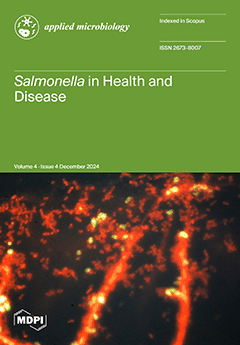Salmonella enterica is a globally important zoonotic microorganism that affects pigs and can enter the farm through various routes. This study aimed to determine the prevalence of
S. enterica in water sources and pigs at Colombian pig farms, and to characterize the antimicrobial resistance of the isolates phenotypically and genotypically. Samples were collected from 103 farms including source water (
n = 104), storage tank water (
n = 103), drinking water (
n = 103), and individual rectal swab samples (
n = 1025). The presence of
Salmonella was detected/identified using MDS-3M™ agar culture medium. Isolates were serotyped, and their antibiotic susceptibility was determined by minimum inhibitory concentration (MIC). Whole genome sequencing (WGS) was performed using Illumina NovaSeq, and bioinformatics analysis focused on serovar confirmation, MLST determination, and resistance gene detection. The overall between-farm prevalence of
Salmonella enterica including all types of samples was 52.4% (54/103), with 6.4% of rectal swab samples and 21.3% of water samples found to be positive. Thirty serovars were identified using WGS, with the most common being
S. Typhimurium var. monophasic (1,4,[5],12:i:-) (41.2%),
S. Schwarzengrund (4.2%), and
S. Saintpaul (4.2%).
Salmonella Typhimurium and its monophasic variant were more commonly found in rectal swabs than the remaining serotypes (relative risk = 2.9,
p < 0.0001), which were commonly found in the water samples (relative risk = 5.2,
p < 0.0001). High levels of phenotypic resistance were observed, particularly to amikacin (99.2%), tetracycline (59.7%), chloramphenicol (55.5%), and ampicillin (42%). All isolates carried genes conferring resistance to aminoglycosides (aac(6′)-Iaa), quinolones (qnrB19), and tetracyclines (tetA). In conclusion,
S. enterica is prevalent in Colombian pig farms including the water supply, with the
S. Typhimurium monophasic variant being predominant, and antimicrobial resistance is widespread.
Full article




